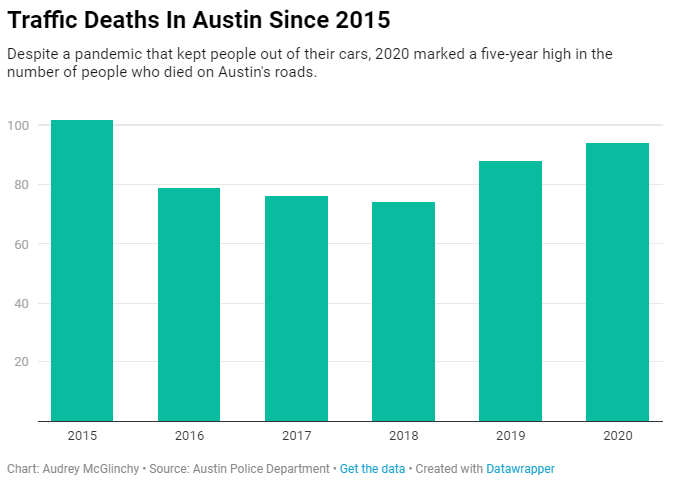
By AUDREY MCGLINCHY, Austin Monitor
The first traffic death on Aug. 26 happened just before 7 a.m.
A man was making a left-hand turn out of an apartment complex in West Austin; he was killed after his car collided with a Jeep Cherokee. Later that day a bicyclist ran a red light and collided with a driver heading south on Highway 183. Two minutes later another bicyclist was killed, this time after a driver rear-ended him.
That one day serves as an example of an uptick in fatalities in 2020. A total of 94 people died on Austin roads last year, marking the highest number of traffic deaths in the city in five years.
This might seem less remarkable if 2020 weren’t a year many people stayed home; with the COVID-19 pandemic raging since late March, drivers largely stayed off Austin’s roads. Traffic safety experts readied themselves for a dip in traffic deaths.
“We thought that if we could get people out of their cars … and working from home, that we would get a double bonus of less congestion on the roads and less people getting hurt and killed,” said Robert Wunderlich, director of the Center for Transportation Safety at the Texas A&M Transportation Institute.
Instead, many cities around the country saw an uptick in traffic fatalities. In Austin, traffic deaths rose by 7 percent, even as the miles people drove at times dropped by nearly 80 percent.
Wunderlich and other road safety experts believe the cause is speed: Without traffic to slow people down, drivers were crashing into pedestrians, bicyclists and other drivers with deadly force.
“Knowing that the physics of a crash is what determines the severity of the injury and knowing where these crashes are happening more frequently on higher-speed roadways, it is easy to infer that speed is a factor and is an increasing factor this year,” Lewis Leff, transportation safety officer with the city, said.
And while traffic deaths rose in Austin, serious injuries caused by crashes went down. As of late December, serious traffic injuries were down 22 percent compared to 2019.
In other words, the crashes that did take place were deadlier.
“Of the people that got into bad crashes, more people died,” Jay Blazek Crossley, director of Vision Zero Texas, said. “Every mile an hour faster you go, the more likely someone will die in a crash.”
The effect is exponential. One study found that a pedestrian hit by a driver going 24.1 miles per hour has a 10 percent chance of being killed. Double the driver’s speed – up to 40 mph – and the pedestrian’s chance of being killed is five times greater.
“So, speed really explains the idea that we had less really bad crashes, but they were more fatal,” Crossley said.
Last summer, City Council members approved a plan to lower speed limits on most of the city’s streets. The speed limits on many downtown streets were reduced from 30 mph to 25 mph.
While Leff said he believes that should get the city closer to its goal of zero traffic deaths and serious injuries by 2025, many traffic deaths happen on highways, which are controlled by the state. Roughly 1 out of every 5 people who died in Austin last year were on Interstate 35 or one of its frontage roads.
The city’s Vision Zero plan posits that relying on people to change their driving behavior won’t make streets safer, that inevitably people will make mistakes and poor choices. Instead, streets should be designed so death is not a result.
Crossley said one upside of the global pandemic is that it has asked people to consider the health and well-being of others alongside their own.
“All of us have been trained in a dialogue of public health, and I think that will actually benefit Americans long-term,” Crossley said. “(In 2020,) all of us have been forced to think about how our daily decisions might actually impact other people’s lives. … Choosing not to wear a mask while COVID is running through the streets … you’re deciding to endanger other people and it’s a disregard for human life. Just the same, driving dangerously is a disregard for the safety and health of other people.”
This story was produced as part of the Austin Monitor’s reporting partnership with KUT. The Austin Monitor is an online, nonpartisan, 501(c)3 nonprofit publication that covers local government and politics in and around Austin.

